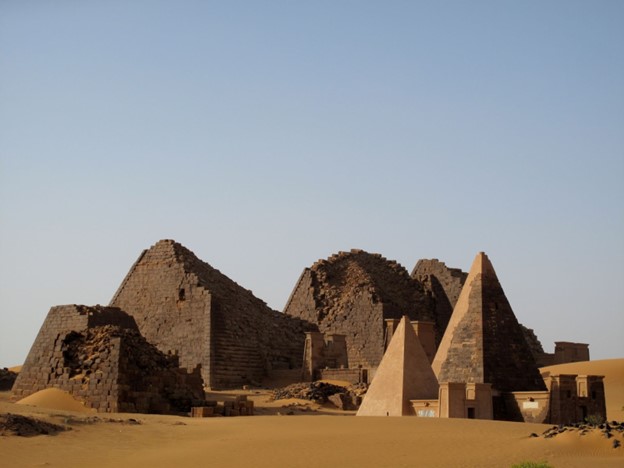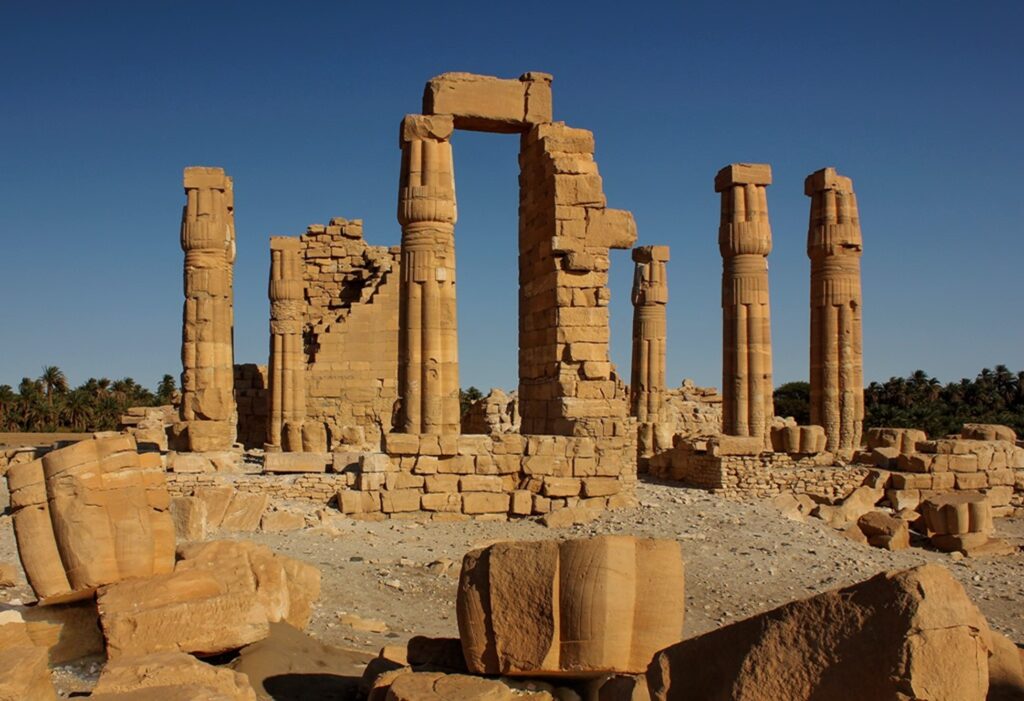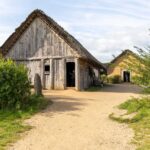Located in northeastern Africa, Sudan is a country steeped in rich history. Home to a wealth of archaeological sites and ancient wonders, Sudan is a must-visit country for travelers fascinated by history. From the pyramids of Nuri and El Kurru to the country’s national museum, countless destinations in Sudan offer a unique glimpse into the country’s past.
In this blog, we will explore some of our favorite destinations to visit in Sudan. Join us for plenty of inspiration for making your dream trip!
If you’d like to explore Sudan’s historical sites with an expert academic guide, consider joining our 14-Day Sudan Tour: An Exploration of Ancient Kush. This unmissable expedition, which explores the region’s most remarkable sites, includes tall pyramids, mud-brick buildings, painted tombs, and carved temples.
What Was Sudan Called in Ancient Times?
Before making our selection of our favorite historical sites in Sudan, we’ll answer a question that’s often asked in relation to the country.
In ancient times, the region that is now Sudan was known by various names depending on the era and the ruling powers at the time. One of the earliest recorded names for the region was “Kush,” which was an ancient kingdom that existed in Sudan around 1000 BCE.
The Kingdom of Kush was located in the Upper Nile Valley and was known for its powerful armies, advanced ironworking, and impressive architecture. The capital of Kush was located at Meroë, which is located in present-day Sudan.
Other ancient names for the region that is now Sudan include “Nubia,” which was used to describe the area between the First and Sixth Cataracts of the Nile River, and “Punt,” which was a land to the east of Egypt that was known for its trade in exotic goods such as incense, myrrh, and gold.
Meroë
Meroë is an ancient city and an important center of the Kingdom of Kush in eastern Sudan. It is famed for its impressive pyramids, built between 300 BC and 350 AD. This was also the site of the burials of the kings and queens of the Meroitic dynasty.
Meroë is a fascinating destination for history-loving travelers because of its unique cultural heritage and the fine preservation of its ancient structures. Visitors to Meroë will see over 200 pyramids spread across three main necropolises, making it the largest collection of pyramids south of Egypt.
The pyramids are unique in their architectural style, featuring steep angles and smaller bases than their Egyptian counterparts. They are decorated with colorful hieroglyphics and murals that tell the stories of the kings and queens buried inside. In addition to the pyramids, visitors can explore the ruins of the city itself, which include royal palaces, temples, and residential areas.
The most famous is the Temple of Amun, built by King Natakamani in the 1st century AD, which features captivating reliefs depicting the pharaohs and the gods. Overall, Meroë offers a fascinating glimpse into the history and culture of one of Africa’s most powerful and influential kingdoms.
Meroë is one of the highlights of our 14-Day Tour of Sudan.
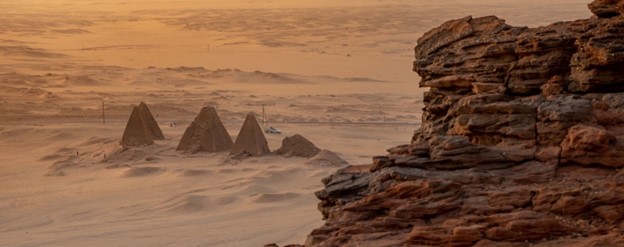
Jebel Barkal
Jebel Barkal is a site located in northern Sudan and is considered one of the most important archaeological destinations in the country. The site includes a towering sandstone mountain that was considered a sacred site in ancient times, as well as the ruins of an ancient city and several temples.
The most famous of these temples is the Temple of Mut, built during the 18th Dynasty of Egypt and is dedicated to the goddess Mut, the wife of Amun. The site is believed to have been an important center of worship for the Egyptians and the Nubians, and the temple itself is a testament to the blending of their cultures.
Visitors can see the temple’s well-preserved reliefs, which feature Egyptian gods and pharaohs alongside Nubian symbols and figures. Additionally, the site offers stunning views of the surrounding landscape and the Nile River, adding to its overall appeal.
The Temple of Soleb
A UNESCO World Heritage Site, the Temple of Soleb is a wondrous historical site. It’s located on the west bank of the Nile and has been used for various purposes throughout its history. The temple was constructed during the reign of Amenhotep III and was dedicated to Amun before being rededicated to Aten when Akhenaten took power.
It was built using traditional Egyptian methods and features a peristyle court and hypostyle hall that lead to the sanctuaries. Visitors can enter through a pylon doorway and proceed down an avenue of ram sphinxes. The walls of the first courtyard display several religious scenes, including a Sed-Festival scene.
The Temple of Soleb is a unique expression of the Egyptian presence in Nubia during the Eighteenth Dynasty, with high economic and commercial potential. It is protected under the Antiquities Protection Ordinance of 1999 and is funded by the Qatar Sudan Archaeological Project.
The temple offers unique insights into the changing beliefs from the God Amun to the God Aten. Its historical significance and cultural value make it a must-visit destination for anyone interested in exploring the rich history of Egypt and Nubia.
We will visit the Temple of Soleb on our 14-Day Tour of Sudan.
El Kurru
El Kurru, located just 20km south of Karima, is a treasure trove of ancient history. Dozens of tombs can be found in this royal cemetery. Two are tremendously well-preserved and can be explored to this day. Belonging to King Tanwetamani and Queen Qalhata, these tombs date back to the 7th century BC and offer visitors a rare opportunity to step into the final resting place of royalty.
To enter, visitors must descend a flight of stairs cut out of the rock, revealing remarkably preserved paintings that showcase the impressive artistic skills of this ancient civilization. The tombs provide a captivating insight into the beliefs and traditions of the past, making it a must-visit for anyone interested in the rich history of Sudan.
Don’t miss the chance to explore this remarkable site and discover the fascinating stories of King Tanwetamani and Queen Qalhata. It’s an unforgettable journey back in time that you won’t regret taking.
Tombos
The archaeological site of Tombos in Sudan is a hidden gem that offers an incredible insight into the ancient world. This historic site is home to the remains of an ancient Nubian town that dates back to around 1500 BC. Here, visitors can see the fascinating ruins of ancient buildings, including temples and tombs, once a part of this bustling community.
One of the most exciting discoveries at Tombos is the royal burial ground, which was found intact and contained the remains of several Nubian kings and queens. These royal tombs are adorned with intricate carvings and paintings, showcasing the remarkable artistic skills of the Nubian people.
But the site’s historical significance doesn’t end there. Tombos also played a crucial role in ancient Egypt’s history, serving as an important trade and military center. It was the southernmost point of Egyptian rule, and visitors can still see the remains of fortifications built to protect the region.
Our tour of the archaeological site of Tombos is the perfect opportunity for history buffs and adventurers to explore this ancient site and learn more about the fascinating history of Sudan. Our expert guides will lead you through the ruins, sharing stories and insights into the rich cultural heritage of the area. Don’t miss the chance to discover the secrets of Tombos and immerse yourself in the history of this incredible site. Join us on our Sudan Tour!
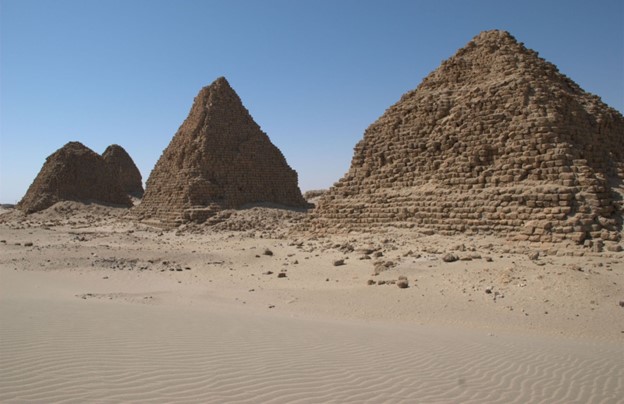
Nuri
Nuri is a burial site that dates back to the Kingdom of Kush and served as a burial ground for pharaohs and their families. Visitors can see numerous pyramids, including the 50-meter-tall pyramid of Taharqa, which is adorned with intricate carvings and inscriptions.
Nuri is one of the few historical sites in Sudan that has yet to be extensively excavated or restored, allowing visitors to see the pyramids in a relatively untouched state. It’s a chance to immerse yourself in the rich history and culture of the Kingdom of Kush and explore a site steeped in mystery and wonder, located in a stunning natural setting with the Nile River and desert landscape providing an extraordinary backdrop.
The National Museum of Sudan*
The National Museum of Sudan is a must for anyone visiting Khartoum! You’ll be blown away by the treasures that await you inside the museum. One of the unique aspects of the National Museum of Sudan is its incredible collection of artifacts from the Kingdom of Kush. You’ll find everything from intricate gold jewelry to fascinating hieroglyphics that offer insight into the beliefs and practices of the ancient Kushite civilization.
But that’s not all. The museum also houses exhibits focused on other Sudanese empires and cultures, including the Christian kingdoms of medieval Sudan and the Islamic kingdoms of the Funj and the Mahdist period.
Some of our favorite highlights from the National Museum of Sudan include the statues of ancient gods and pharaohs, the collection of Nubian pottery, and the fascinating funerary masks and coffins that were used to prepare bodies for burial in ancient times.
The most famous exhibits within the museum, though, are undoubtedly the mummified remains of the Kushite pharaohs. Preserved for thousands of years, they are a testament to the incredible skill and artistry of ancient embalmers and an incomparable opportunity to look into the faces of rulers from ancient history.
*Please note: The National Museum of Sudan is currently closed for refurbishment. It is expected that the museum will reopen in 2024 but, as always, these dates are estimates and subject to change. If traveling to Sudan, check the museum’s website for the latest information.
Sudan is an utterly fascinating destination for those passionate about history and archaeology. Our 14-Day Tour of Sudan is a unique opportunity to journey to the country’s most amazing sites in the company of a leading expert in Kushite history.
If you’ve yet to decide which historic destination to visit next, please browse our full range of Worldwide History Tours.
If you have any questions, please contact us.
